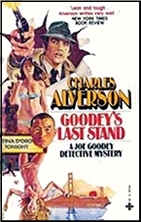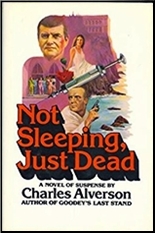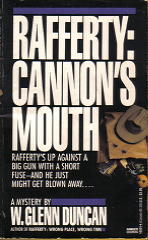
W. GLENN DUNCAN passed away on May 7th of last year. He was the author of six books about a PI named Rafferty (no first name known). Rafferty, whose home base was Dallas TX, was definitely in the Spenser tradition, but with a Gold Medal sensibility. if that makes sense. (All of his books were paperback originals published by Fawcett Gold Medal. )
Rafferty is also known for the set of Rules he lives by, and many of them are quoted throughout his adventures. (See below.)
The Rafferty series —
Rafferty’s Rules (1987). Film: Cinepix, 1992, as Snake Eater III: His Law.
Last Seen Alive (1987)
Poor Dead Cricket (1988)
Wrong Place, Wrong Time (1989)
Cannon’s Mouth (1990)
Fatal Sisters (1990)
— By W. Glenn Duncan, Jr.
False Gods (2018)
Rafferty’s Rules, as compiled by Kevin Burton Smith
2) Be lucky. (Wrong Place, Wrong Time)
3) If you’re going to be stupid, see rule number two. (Wrong Place, Wrong Time)
3) When all else fails, sit on your duff and await good news…
5) If a client can afford it, he — or she — pays top dollar.
6) Don’t forget the money.
7) Anxious clients who smile too much are usually trouble.
8) The client has to say out loud what he wants me to do. (Rafferty’s Rules)
8) When in doubt, raise hell and see who complains about the noise. (Last Seen Alive)
9) Dull won’t balance the checkbook.
11) Don’t worry about what’s right, worry about what’s possible.
11) To feel really dumb, be a smart ass once too often. (Wrong Place, Wrong Time)
12) Selling people is antisocial.
13) Get the money up front.
16) When you can’t tell the bad guys from the good guys, it’s time to get the hell out. (Wrong Place, Wrong Time)
17) Never take a client at face value.
18) Ribs should be eaten naked.
19) When you can’t tell the bad guys from the good guys, it’s time to get the hell out. (Wrong Place, Wrong Time)
20) Any hunch so strong that it hurts just has to be right. (Cannon’s Mouth)
21) Grow up and grow old.
22) Don’t skulk. You can get away with anything if you act like you’re supposed to be doing it.
23) You show me a man who always “fights fair†and I’ll show you a man who loses too often.
27) In one way or another, every client lies. (Even Rafferty isn’t sure if this is #27 or not.)
28) Hot coffee and nudity don’t mix. If you spill, it hurts.
33) Always obey your friend, the police man.
34) Sometimes good luck accomplishes more than hard work. (Rafferty’s Rules)
34) When in doubt, dodge. (Wrong Place, Wrong Time)
34) Clients always hold back something back. (Last Seen Alive)
35) If a client appears to be telling you everything, see rule #34. (Last Seen Alive)
39) Smiting the wicked sounds biblical, but mostly it’s good clean fun.
41) When someone mentions how good something “could†be, they’re really telling me how lousy that something is.
47) Wear steel-toed boots when kicking people on their bony parts.



